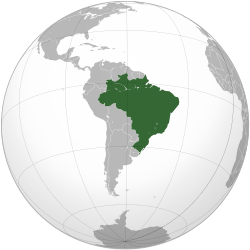
Back الجمهورية البرازيلية الأولى Arabic Стара република Bulgarian Primera República Brasilera Catalan کۆماری یەکەمی بەڕازیل CKB Første Brasilianske Republik Danish Erste Brasilianische Republik German República Velha Spanish جمهوری اول برزیل Persian República Velha French היסטוריה של ברזיל: הרפובליקה הישנה (1889–1930) HE
This article needs additional citations for verification. (November 2020) |
You can help expand this article with text translated from the corresponding article in Portuguese. (September 2011) Click [show] for important translation instructions.
|
Republic of the United States of Brazil República dos Estados Unidos do Brasil | |||||||||
|---|---|---|---|---|---|---|---|---|---|
| 1889–1930 | |||||||||
| Motto: Ordem e Progresso "Order and Progress" | |||||||||
| Anthem: | |||||||||
 Brazil at its largest territorial extent, including Acre | |||||||||
| Capital | Rio de Janeiro | ||||||||
| Common languages | Portuguese | ||||||||
| Government | Military dictatorship (1889–1894) Oligarchic federal presidential republic (1894–1930) | ||||||||
| President | |||||||||
• 1889–1891 | Deodoro da Fonseca (first) | ||||||||
• 1926–1930 | Washington Luís (last) | ||||||||
| Legislature | National Congress | ||||||||
| Senate | |||||||||
| Chamber of Deputies | |||||||||
| Historical era | 19th–20th century | ||||||||
| 15 November 1889 | |||||||||
| 24 February 1891 | |||||||||
| 1893–1894 | |||||||||
| 1893–1895 | |||||||||
• Civilian rule | 15 November 1894 | ||||||||
| 3 November 1930 | |||||||||
| Population | |||||||||
• 1890 | 14,333,915 | ||||||||
• 1900 | 17,438,434 | ||||||||
• 1920 | 30,635,605 | ||||||||
| Currency | Real | ||||||||
| ISO 3166 code | BR | ||||||||
| |||||||||
| Part of a series on the |
| History of Brazil |
|---|
 |
|
|
The First Brazilian Republic, also referred to as the Old Republic (Portuguese: República Velha Portuguese pronunciation: [ʁeˈpublikɐ ˈvɛʎɐ]), officially the Republic of the United States of Brazil, refers to the period of Brazilian history from 1889 to 1930. The Old Republic began with the deposition of Emperor Pedro II in 1889, and ended with the Brazilian Revolution of 1930 that installed Getúlio Vargas as a new president. During the First Brazilian Republic, Brazil was dominated by a form of machine politics known as coronelism, in which the political and economic spheres were dominated by large landholders. The most powerful of such landholders were the coffee industry of São Paulo and the dairy industry of Minas Gerais. Because of the power of these two industries, the Old Republic's political system has been described as "milk coffee politics."
© MMXXIII Rich X Search. We shall prevail. All rights reserved. Rich X Search

